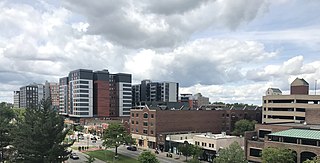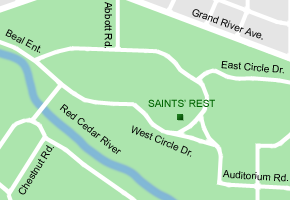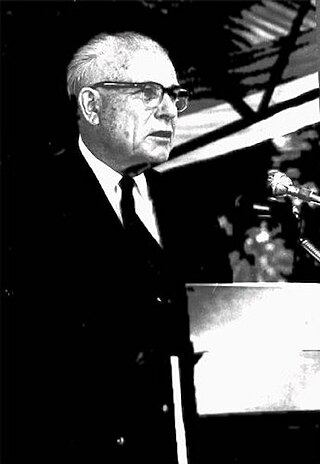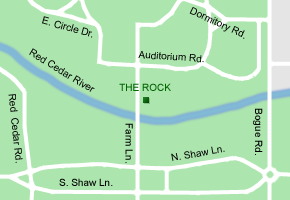
East Lansing is a city in the U.S. state of Michigan. Most of the city lies within Ingham County with a smaller portion extending north into Clinton County. At the 2020 Census the population was 47,741. Located directly east of the state capital of Lansing, East Lansing is well-known as the home of Michigan State University. The city is part of the Lansing–East Lansing metropolitan area.

Michigan State University is a public land-grant research university in East Lansing, Michigan. It was founded in 1855 as the Agricultural College of the State of Michigan, the first of its kind in the United States. After the introduction of the Morrill Act in 1862, the state designated the college a land-grant institution in 1863, making it the first of the land-grant colleges in the United States. The college became coeducational in 1870. Today, Michigan State has rapidly expanded its footprint across the state of Michigan with facilities all across the state and one of the largest collegiate alumni networks with 634,000 members.

Sparty is the mascot of Michigan State University. Sparty is usually depicted as a muscular male Spartan warrior/athlete dressed in stylized Greek costume. After changing the team name from "Aggies" to "Spartans" in 1925, various incarnations of a Spartan warrior with a prominent chin appeared at university events and in university literature. In 1943, MSU art professor Leonard D. Jungwirth designed a statue for the university, which had to be cast in terra cotta because of World War II rationing. In 2005, the university replaced Jungwirth's original statue with a bronze replica, moving the original indoors to protect it from the elements.

Saints' Rest was the second building erected on the campus of the Agricultural College of the State of Michigan. It was built in 1856 and served as the school's only dormitory until 1870, when Williams Hall was completed. Along with College Hall and a horse barn, it was one of three buildings completed when the college opened for classes in 1857.

The Beaumont Tower is a structure on the campus of Michigan State University, designed by the architectural firm of Donaldson and Meier and completed in 1928. The 104-foot-tall (32 m) tower marks the site of College Hall, the first building constructed on the campus, as well as the first building in America erected for instruction in scientific agriculture. Due to poor construction, College Hall collapsed in 1918. John W. Beaumont, an 1882 alumnus of MSU, proposed the construction of the monument to conserve the Campus Circle and serve as a monument to teaching.

John Alfred Hannah was president of Michigan State College for 28 years (1941–1969), making him the longest serving of MSU's presidents. He is credited with transforming the school from a regional undergraduate college into a large national research institution. After his resignation from the university, Hannah became head of the United States Agency for International Development (USAID).

The Rock is a boulder on the campus of Michigan State University. Once popular as a trysting site, today it serves as a billboard for campus groups and events.

WDBM, East Lansing, Michigan, United States, branded Impact 89FM, is a 2,000 watt, Class A, student-run college radio station at Michigan State University that broadcasts to listeners in the Lansing metropolitan area. The signal can be heard as far south as Jackson, Michigan, southeast almost to Brighton, and north to Alma, far beyond its 60 dBu service contour which represents its clearest signal. The station is the successor to the Michigan State Network, which in the 1970s was the nation's largest college carrier current radio network, and had studios in several MSU dormitories. The network was eventually consolidated to one carrier current station, WLFT, which broadcast from the former WKAR studios on the third floor of the MSU Auditorium Building. This was also the first home of WDBM-FM.

Alice B. Cowles House is a structure on the campus of Michigan State University. It is the oldest extant building on MSU's campus, though only the foundation and two exterior walls remain from the original 1857 construction.

The Michigan State University Horticulture Gardens are horticultural gardens, with a landscape arboretum, located on Bogue Street on the Michigan State University campus in East Lansing, Michigan. The gardens are open to the public daily without charge.
The history of Michigan State University dates back to 1855, when the Michigan Legislature established the Agricultural College of the State of Michigan under the encouragement of the Michigan State Agricultural Society and the Michigan Farmer, the state's leading agricultural periodical. As the first agricultural college in the United States, the school served as a model for other institutions of its kind established in the period, to give an instance, the Agricultural College of Pennsylvania.

The campus of Michigan State University is located in East Lansing on the banks of the Red Cedar River, and comprises a contiguous area of 5,200 acres (21 km2), 2,000 acres (8.1 km2) of which are developed. Built amid virgin forest, the campus opened in 1855 with three buildings, none of which remain. As an agricultural college, the campus was originally located several miles outside of the city of Lansing, but as the population of the college grew, the city of East Lansing developed just north of the area's main avenue.

Demonstration Hall is a structure on the campus of Michigan State University. It was built in 1928 with offices, classrooms, and a riding arena for the Military Science department as a replacement for the Armory. Exhibitions of agricultural stock and implements were held here, as well as athletic events. It served as the home court for the Michigan State Spartans men's basketball team from 1930 to 1940, and the ice rink for the Michigan State Spartans men's ice hockey team from 1949 until Munn Ice Arena was completed in 1974.

The Michigan State Spartans football program represents Michigan State University (MSU) in college football at the NCAA Division I Football Bowl Subdivision (FBS) level. The Spartans are members of the Big Ten Conference. Michigan State claims a total of six national championships, including two from major wire-service: AP Poll and/or Coaches' Poll. The Spartans have also won eleven conference championships, with two in the Michigan Intercollegiate Athletic Association and nine in the Big Ten.

John Clough Holmes was an American agriculturalist, educator, and co-founder of the Michigan State Agricultural Society. Holmes is also known as the founder of Michigan State University, established in 1855 as an agriculture college, the first of its kind in the United States. Holmes Hall, the home of the Lyman Briggs College, is named in his honor.
Michigan State University Housing is a large and complex network of housing for students and faculty of Michigan State University. Most of the housing is in the form of residence halls on the school's campus, but there are also university apartments, fraternity and sorority housing, and free-standing housing for grad students, faculty and staff.
The Michigan State University Vietnam Advisory Group was a program of technical assistance provided to the government of South Vietnam as an effort in state-building by the US Department of State.

The Eugene C. Eppley Center is located on the Michigan State University campus in East Lansing, Michigan. It is home to a number of units within the Eli Broad College of Business, including the Department of Finance, the Full-Time Masters in Business Administration (MBA) Program offices, the MBA Career Services Center, the International Business Center (IBC)/Center for International Business Education and Research (CIBER), Multicultural Business Programs, The School of Hospitality Business, Undergraduate Academic Services, the financial analysis lab, the IBM On-Demand Supply Chain Laboratory, the Management Information Systems (MIS) Laboratory, the Team Effectiveness Teaching Laboratory, and the Lear Corporation Career Services Center.
The Michigan State University Federal Credit Union (MSUFCU) is a credit union headquartered in East Lansing, Michigan. Primarily serving students and alumni of Michigan State University and Oakland University, MSUFCU is federally chartered and regulated by the National Credit Union Administration (NCUA). MSUFCU is the largest university-based credit union in the world, and the second-largest credit union in Michigan.

The Michigan State University College of Osteopathic Medicine (MSUCOM) is one of the two public medical schools of Michigan State University, a public land-grant research university in East Lansing, Michigan. The college grants the Doctor of Osteopathic Medicine (D.O.) degree, as well as a DO-PhD combined degree for students interested in training as physician-scientists. MSUCOM operates two satellite campuses in Clinton Township and Detroit. The college is accredited by the American Osteopathic Association's Commission on Osteopathic College Accreditation (COCA) and by the Higher Learning Commission.

















